GMBA8021 Assignment 2: Investment Decisions for Airline Companies
VerifiedAdded on 2022/08/31
|11
|2806
|18
Report
AI Summary
This report presents a comprehensive financial analysis of Qantas Airways and Virgin Australia, two major players in the Australian airline industry. The analysis, conducted for the GMBA8021 course, includes horizontal and vertical analyses of financial statements to identify trends and evaluate performance. The report also develops next-year budget propositions based on the trend analysis and provides financial recommendations for each company, considering factors like revenue, costs, assets, and liabilities. Furthermore, the report incorporates the concept of the Innovator's Dilemma, discussing its relevance to the airline industry and the strategic decisions faced by both companies. The findings highlight the financial strengths and weaknesses of each airline, ultimately leading to an investment recommendation based on a comparative assessment. The report also provides suggestions for improvements from a financial perspective.
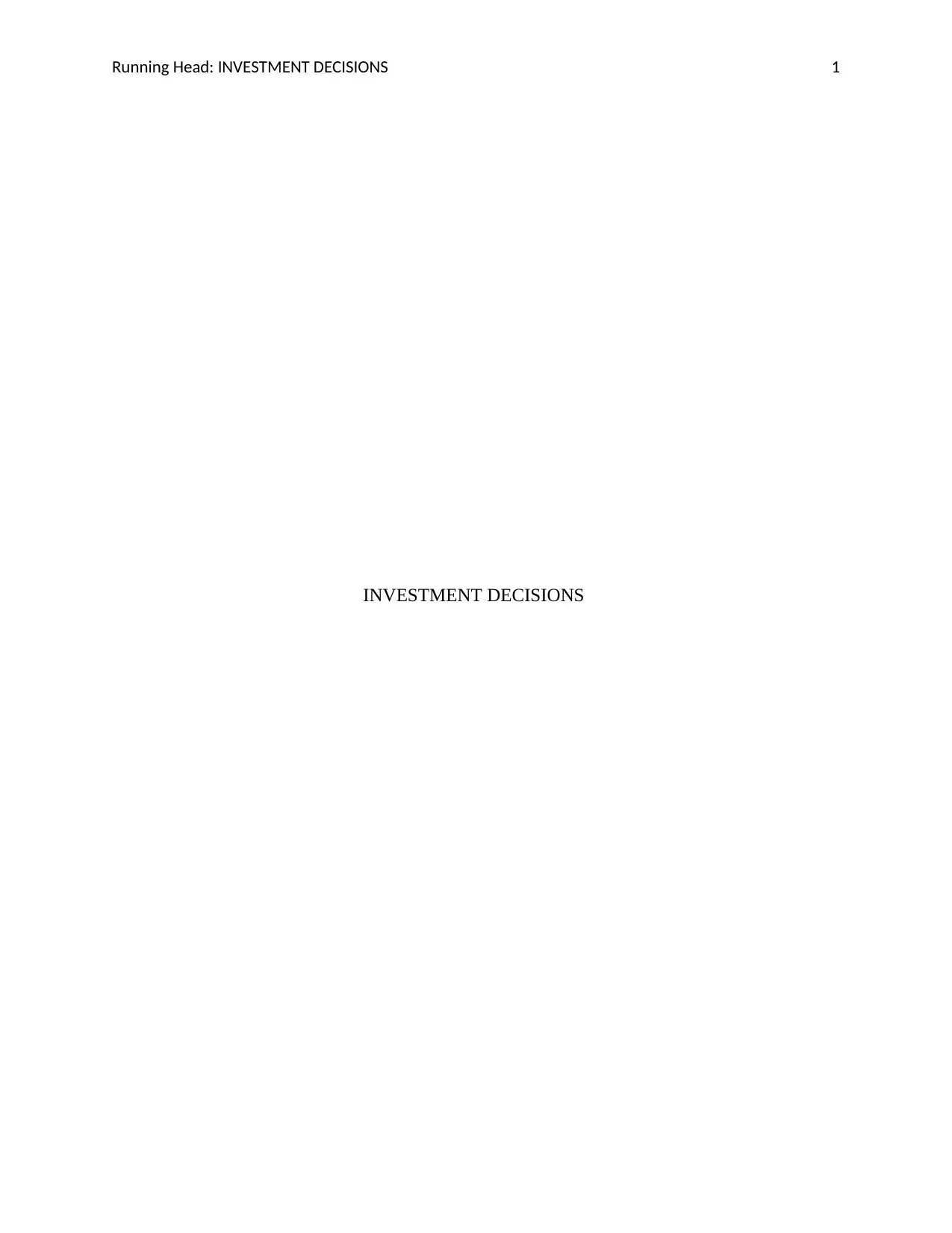
Running Head: INVESTMENT DECISIONS 1
INVESTMENT DECISIONS
INVESTMENT DECISIONS
Paraphrase This Document
Need a fresh take? Get an instant paraphrase of this document with our AI Paraphraser

INVESTMENT DECISIONS
Contents
Overview..........................................................................................................................................3
Horizontal Analysis.........................................................................................................................3
Vertical Analysis.............................................................................................................................5
Next year budget propositions.........................................................................................................6
Recommendations............................................................................................................................8
Innovator’s dilemma........................................................................................................................8
References........................................................................................................................................9
Contents
Overview..........................................................................................................................................3
Horizontal Analysis.........................................................................................................................3
Vertical Analysis.............................................................................................................................5
Next year budget propositions.........................................................................................................6
Recommendations............................................................................................................................8
Innovator’s dilemma........................................................................................................................8
References........................................................................................................................................9

INVESTMENT DECISIONS
Overview
Qantas Airways Limited is an airline service that is largest airline by its size,
international coverage and the flights. The company that was predominantly founded in
Queensland, on 16th of November in the year 1920, by Hudson Fysh, Paul mc Ginness and
Fergus McMaster. The total fleet size of the company is 132 and the total destinations covered
by the airline are 85. The company is traded as QAN on Australian Stock exchange and there are
primary as well as secondary hubs where Qantas operates.
Virgin Australia, on the other hand is also one of the largest airline service provider who
commenced its operations in the years 2000. It abruptly wound up as a significant carrier in
Australia's local market after the breakdown of Ansett Australia in September 2001. The aircraft
has since developed to legitimately serve 42 urban communities in Australia, from center points
in Brisbane, Melbourne and Sydney.
Horizontal Analysis
Horizontal examination is the process in which the transactions of the previous year are
analyzed with respect to the current year. This technique for examination is otherwise called
pattern investigation. Horizontal Examination permits the appraisal of relative changes in various
things after some time. It additionally shows the conduct of incomes, costs, and other details of
budget reports through the span of time. Further, in this section the horizontal analysis has been
undertaken for Qantas Airways and Virgin Australia (Efinance management.com, 2019).
The horizontal analysis states that revenue has increased from 4.88% and the cost have
also increased from 4.02%. Due to the increase in the cost of sales and other operating expenses
Overview
Qantas Airways Limited is an airline service that is largest airline by its size,
international coverage and the flights. The company that was predominantly founded in
Queensland, on 16th of November in the year 1920, by Hudson Fysh, Paul mc Ginness and
Fergus McMaster. The total fleet size of the company is 132 and the total destinations covered
by the airline are 85. The company is traded as QAN on Australian Stock exchange and there are
primary as well as secondary hubs where Qantas operates.
Virgin Australia, on the other hand is also one of the largest airline service provider who
commenced its operations in the years 2000. It abruptly wound up as a significant carrier in
Australia's local market after the breakdown of Ansett Australia in September 2001. The aircraft
has since developed to legitimately serve 42 urban communities in Australia, from center points
in Brisbane, Melbourne and Sydney.
Horizontal Analysis
Horizontal examination is the process in which the transactions of the previous year are
analyzed with respect to the current year. This technique for examination is otherwise called
pattern investigation. Horizontal Examination permits the appraisal of relative changes in various
things after some time. It additionally shows the conduct of incomes, costs, and other details of
budget reports through the span of time. Further, in this section the horizontal analysis has been
undertaken for Qantas Airways and Virgin Australia (Efinance management.com, 2019).
The horizontal analysis states that revenue has increased from 4.88% and the cost have
also increased from 4.02%. Due to the increase in the cost of sales and other operating expenses
⊘ This is a preview!⊘
Do you want full access?
Subscribe today to unlock all pages.

Trusted by 1+ million students worldwide
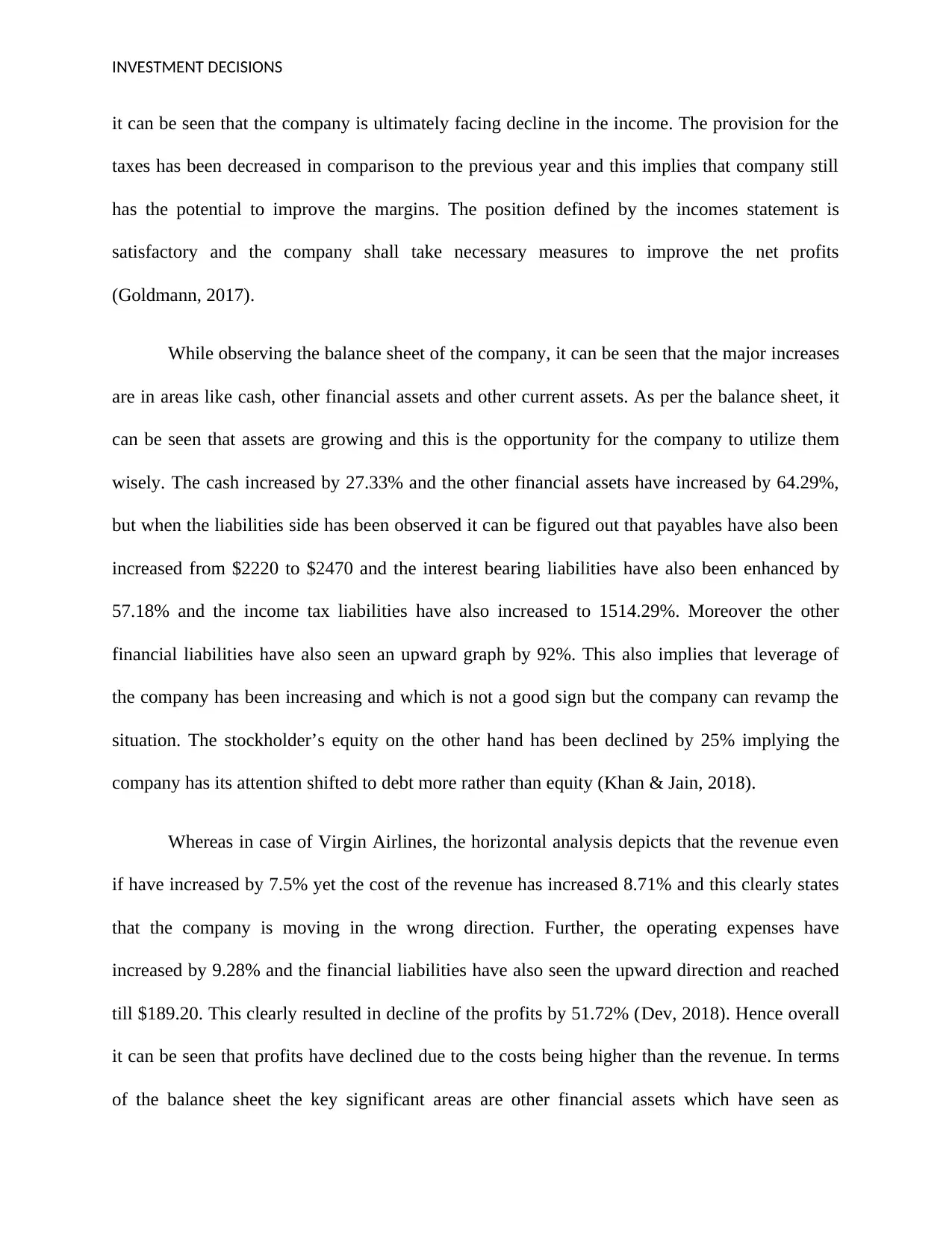
INVESTMENT DECISIONS
it can be seen that the company is ultimately facing decline in the income. The provision for the
taxes has been decreased in comparison to the previous year and this implies that company still
has the potential to improve the margins. The position defined by the incomes statement is
satisfactory and the company shall take necessary measures to improve the net profits
(Goldmann, 2017).
While observing the balance sheet of the company, it can be seen that the major increases
are in areas like cash, other financial assets and other current assets. As per the balance sheet, it
can be seen that assets are growing and this is the opportunity for the company to utilize them
wisely. The cash increased by 27.33% and the other financial assets have increased by 64.29%,
but when the liabilities side has been observed it can be figured out that payables have also been
increased from $2220 to $2470 and the interest bearing liabilities have also been enhanced by
57.18% and the income tax liabilities have also increased to 1514.29%. Moreover the other
financial liabilities have also seen an upward graph by 92%. This also implies that leverage of
the company has been increasing and which is not a good sign but the company can revamp the
situation. The stockholder’s equity on the other hand has been declined by 25% implying the
company has its attention shifted to debt more rather than equity (Khan & Jain, 2018).
Whereas in case of Virgin Airlines, the horizontal analysis depicts that the revenue even
if have increased by 7.5% yet the cost of the revenue has increased 8.71% and this clearly states
that the company is moving in the wrong direction. Further, the operating expenses have
increased by 9.28% and the financial liabilities have also seen the upward direction and reached
till $189.20. This clearly resulted in decline of the profits by 51.72% (Dev, 2018). Hence overall
it can be seen that profits have declined due to the costs being higher than the revenue. In terms
of the balance sheet the key significant areas are other financial assets which have seen as
it can be seen that the company is ultimately facing decline in the income. The provision for the
taxes has been decreased in comparison to the previous year and this implies that company still
has the potential to improve the margins. The position defined by the incomes statement is
satisfactory and the company shall take necessary measures to improve the net profits
(Goldmann, 2017).
While observing the balance sheet of the company, it can be seen that the major increases
are in areas like cash, other financial assets and other current assets. As per the balance sheet, it
can be seen that assets are growing and this is the opportunity for the company to utilize them
wisely. The cash increased by 27.33% and the other financial assets have increased by 64.29%,
but when the liabilities side has been observed it can be figured out that payables have also been
increased from $2220 to $2470 and the interest bearing liabilities have also been enhanced by
57.18% and the income tax liabilities have also increased to 1514.29%. Moreover the other
financial liabilities have also seen an upward graph by 92%. This also implies that leverage of
the company has been increasing and which is not a good sign but the company can revamp the
situation. The stockholder’s equity on the other hand has been declined by 25% implying the
company has its attention shifted to debt more rather than equity (Khan & Jain, 2018).
Whereas in case of Virgin Airlines, the horizontal analysis depicts that the revenue even
if have increased by 7.5% yet the cost of the revenue has increased 8.71% and this clearly states
that the company is moving in the wrong direction. Further, the operating expenses have
increased by 9.28% and the financial liabilities have also seen the upward direction and reached
till $189.20. This clearly resulted in decline of the profits by 51.72% (Dev, 2018). Hence overall
it can be seen that profits have declined due to the costs being higher than the revenue. In terms
of the balance sheet the key significant areas are other financial assets which have seen as
Paraphrase This Document
Need a fresh take? Get an instant paraphrase of this document with our AI Paraphraser

INVESTMENT DECISIONS
acceleration by 157% and the investments have been sold fully. The liabilities having interest
factor and which are of current nature have been increased by 161% and in this scenario also the
current liabilities are greater than the current assets which imply that the liquidity position is not
so smooth (Lee, Lin & Shin, 2018).
Vertical Analysis
Vertical analysis is the analysis where the percentage of the base figure is calculated to
understand each item in the proportion of the base item. It is one of the most popular methods
which are very simple to understand and hence, it is also required to evaluate the performance of
the business (McLean, 2020).
From the vertical analysis of Qantas Airways, it can be seen that the revenue has been
treated as 100% and the cost of the revenue that has been covered is 46.38% in the year 2018 and
45.99% in the year 2019. The gross profit of the company has been on the positive front but not
too much. On the other hand the sales, general and administrative expenses have been increased
by to 45.6% and this states that the expenses if not controlled by the company will result in
losses in the future. The net income is just 4.96% of the sales and this means that the net profit
margins are lower than expected and also decreased from the previous year, which was 5.56%.
Overall the vertical analysis of the income statement of Qantas Airways displays most of the
percentage is covered by the expenses and this needs to be changed for better performance in
future (Murphy & McGrath, 2016).
The position of the balance sheet is such, the total asses have been treated as 100% and
the rest of the items are taken as percentage of the same. Fixed asset holds the major percentage
in the section of the assets which is 66.97% in the current year and the same has been decreased
acceleration by 157% and the investments have been sold fully. The liabilities having interest
factor and which are of current nature have been increased by 161% and in this scenario also the
current liabilities are greater than the current assets which imply that the liquidity position is not
so smooth (Lee, Lin & Shin, 2018).
Vertical Analysis
Vertical analysis is the analysis where the percentage of the base figure is calculated to
understand each item in the proportion of the base item. It is one of the most popular methods
which are very simple to understand and hence, it is also required to evaluate the performance of
the business (McLean, 2020).
From the vertical analysis of Qantas Airways, it can be seen that the revenue has been
treated as 100% and the cost of the revenue that has been covered is 46.38% in the year 2018 and
45.99% in the year 2019. The gross profit of the company has been on the positive front but not
too much. On the other hand the sales, general and administrative expenses have been increased
by to 45.6% and this states that the expenses if not controlled by the company will result in
losses in the future. The net income is just 4.96% of the sales and this means that the net profit
margins are lower than expected and also decreased from the previous year, which was 5.56%.
Overall the vertical analysis of the income statement of Qantas Airways displays most of the
percentage is covered by the expenses and this needs to be changed for better performance in
future (Murphy & McGrath, 2016).
The position of the balance sheet is such, the total asses have been treated as 100% and
the rest of the items are taken as percentage of the same. Fixed asset holds the major percentage
in the section of the assets which is 66.97% in the current year and the same has been decreased

INVESTMENT DECISIONS
from the previous year. The liabilities ratio indicates that 82.27% of the total assets are liabilities
and this implies that most of the funds are acquired in the form of debt and this also creates huge
liability. Qantas Airways is majorly focused on inviting the debt rather than the equity, but too
much leverage would result in too many complexities (Ratiosys.com. 2019).
While comparing the scenarios, the income statement of Virgin Airlines depicts that
almost half of the percentage has been covered by the cost of the revenue. The gross profit have
been declines and reached till 49.97%. It is clearly evident that cost of the sales needs a reduction
in order to have the higher margins to cover the other expenses. The negative income reflects
that the company has mostly been covering the expenses and therefore there is no profit left for
the shareholders. The cost of sales has increased due to pandemic coronavirus and this has also
affected the trading activities of the business (Rey & Santelli, 2017).
The balance sheet of Virgin Australia defines total liabilities to be 90.43% and the current
liabilities forms 50% of the part. The fixed assets on the other hand forms the 50 % of the part
which is and cash being just 26.90% in the year 2019, but increased from 22.87%. Currently the
current assets are lower than the current liabilities and the percentage of the asset in the form of
the liabilities (Robinson, 2020).
Next year budget propositions
The next year budget propositions on the basis of the horizontal analysis have been
carried out for both Qantas Airways and Virgin Airlines. The budget spending limit is an
estimation of income and costs over a predetermined future timeframe and is used by
governments, organizations, and people. It is fundamentally a monetary arrangement for a
characterized period, majorly for a year but can also be for monthly or quarterly. It incredibly
from the previous year. The liabilities ratio indicates that 82.27% of the total assets are liabilities
and this implies that most of the funds are acquired in the form of debt and this also creates huge
liability. Qantas Airways is majorly focused on inviting the debt rather than the equity, but too
much leverage would result in too many complexities (Ratiosys.com. 2019).
While comparing the scenarios, the income statement of Virgin Airlines depicts that
almost half of the percentage has been covered by the cost of the revenue. The gross profit have
been declines and reached till 49.97%. It is clearly evident that cost of the sales needs a reduction
in order to have the higher margins to cover the other expenses. The negative income reflects
that the company has mostly been covering the expenses and therefore there is no profit left for
the shareholders. The cost of sales has increased due to pandemic coronavirus and this has also
affected the trading activities of the business (Rey & Santelli, 2017).
The balance sheet of Virgin Australia defines total liabilities to be 90.43% and the current
liabilities forms 50% of the part. The fixed assets on the other hand forms the 50 % of the part
which is and cash being just 26.90% in the year 2019, but increased from 22.87%. Currently the
current assets are lower than the current liabilities and the percentage of the asset in the form of
the liabilities (Robinson, 2020).
Next year budget propositions
The next year budget propositions on the basis of the horizontal analysis have been
carried out for both Qantas Airways and Virgin Airlines. The budget spending limit is an
estimation of income and costs over a predetermined future timeframe and is used by
governments, organizations, and people. It is fundamentally a monetary arrangement for a
characterized period, majorly for a year but can also be for monthly or quarterly. It incredibly
⊘ This is a preview!⊘
Do you want full access?
Subscribe today to unlock all pages.

Trusted by 1+ million students worldwide

INVESTMENT DECISIONS
upgrades the achievement of any endeavor. Corporate budgeting plans are basic for working at
top effectiveness. Besides reserving assets, a spending limit can likewise help in defining
objectives, estimating results and making arrangements for possibilities. The budgeted income
statement defines how far the company will go, keeping the percentages intact, and Qantas
delivers the results as follows. The sales will be approximately $18000 and the profit seems to be
decreased in comparison to the previous year. The cost of the operating expenses is seen to be
increased and therefore, the company shall plan accordingly in advance. The budgeted balance
sheet states that the cash must be increased whereas the financial liabilities will increase with
double the percent. The decrease in the equity will result in more troubles and hence, the
company must invest in the equity rather than the debt component (Baheti and Baheti, 2018).
In terms of the Virgin Australia, the budgeted income statement displays the increase
in the net revenue as well as acceleration in the sales and the admin expenses. The losses will be
increased from if the same percentages have been followed. Hence, the company must take
necessary measures like reducing the direct expenses, by in house manufacturing, and
substituting the cost to create the balance. Further, the cash have seen an upside scale and so has
been the situation of the financial assets. This clearly means that the company needs to do some
revision to bring back the company to profitable position. Further while looking at the liabilities
side it can be seen that the Virgin must control the interest bearing liabilities, to reduce the
financial burden. The derivative financial instruments have also been escalating and these results
ultimately project the satisfactory image of the company (Cole, 2019).
upgrades the achievement of any endeavor. Corporate budgeting plans are basic for working at
top effectiveness. Besides reserving assets, a spending limit can likewise help in defining
objectives, estimating results and making arrangements for possibilities. The budgeted income
statement defines how far the company will go, keeping the percentages intact, and Qantas
delivers the results as follows. The sales will be approximately $18000 and the profit seems to be
decreased in comparison to the previous year. The cost of the operating expenses is seen to be
increased and therefore, the company shall plan accordingly in advance. The budgeted balance
sheet states that the cash must be increased whereas the financial liabilities will increase with
double the percent. The decrease in the equity will result in more troubles and hence, the
company must invest in the equity rather than the debt component (Baheti and Baheti, 2018).
In terms of the Virgin Australia, the budgeted income statement displays the increase
in the net revenue as well as acceleration in the sales and the admin expenses. The losses will be
increased from if the same percentages have been followed. Hence, the company must take
necessary measures like reducing the direct expenses, by in house manufacturing, and
substituting the cost to create the balance. Further, the cash have seen an upside scale and so has
been the situation of the financial assets. This clearly means that the company needs to do some
revision to bring back the company to profitable position. Further while looking at the liabilities
side it can be seen that the Virgin must control the interest bearing liabilities, to reduce the
financial burden. The derivative financial instruments have also been escalating and these results
ultimately project the satisfactory image of the company (Cole, 2019).
Paraphrase This Document
Need a fresh take? Get an instant paraphrase of this document with our AI Paraphraser
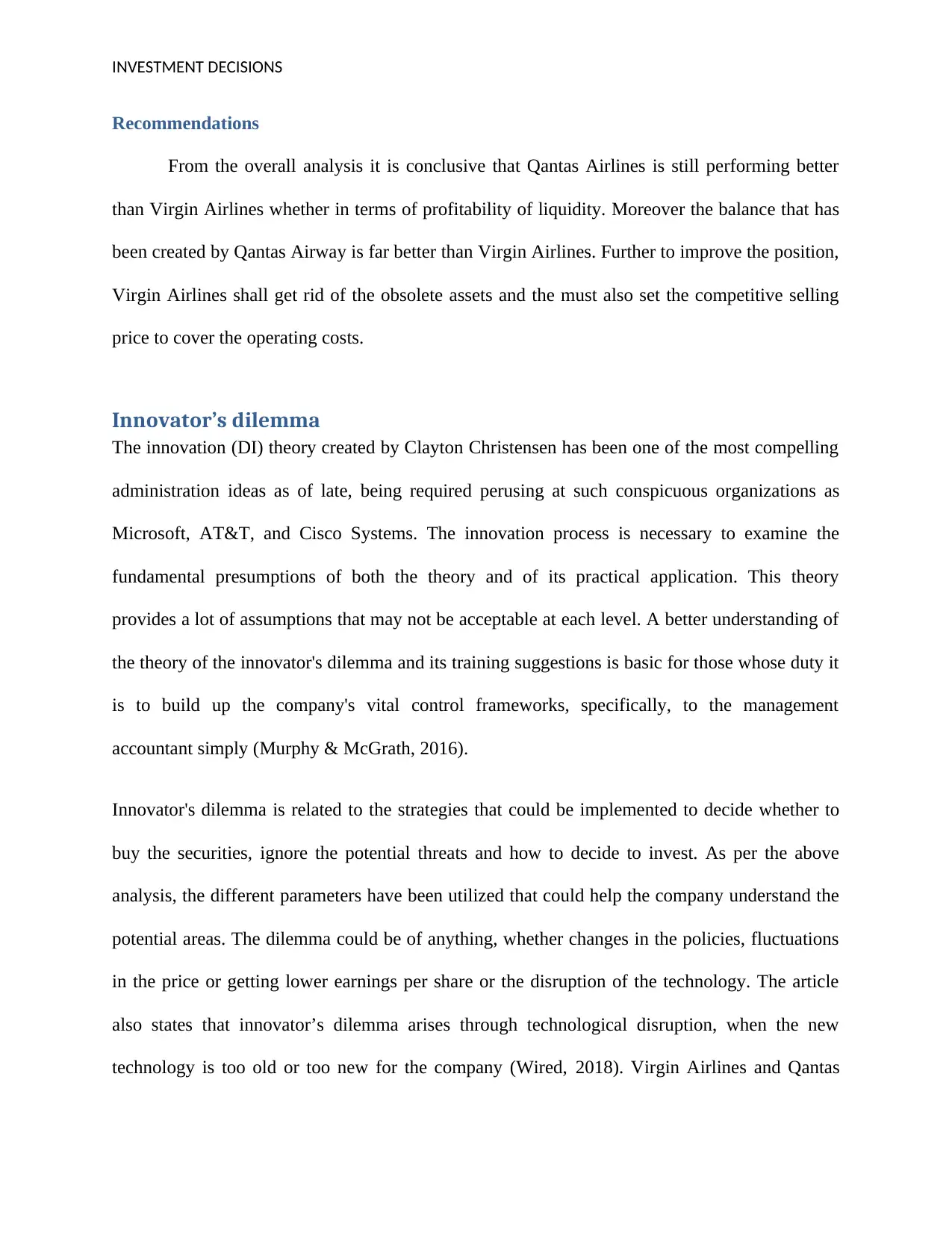
INVESTMENT DECISIONS
Recommendations
From the overall analysis it is conclusive that Qantas Airlines is still performing better
than Virgin Airlines whether in terms of profitability of liquidity. Moreover the balance that has
been created by Qantas Airway is far better than Virgin Airlines. Further to improve the position,
Virgin Airlines shall get rid of the obsolete assets and the must also set the competitive selling
price to cover the operating costs.
Innovator’s dilemma
The innovation (DI) theory created by Clayton Christensen has been one of the most compelling
administration ideas as of late, being required perusing at such conspicuous organizations as
Microsoft, AT&T, and Cisco Systems. The innovation process is necessary to examine the
fundamental presumptions of both the theory and of its practical application. This theory
provides a lot of assumptions that may not be acceptable at each level. A better understanding of
the theory of the innovator's dilemma and its training suggestions is basic for those whose duty it
is to build up the company's vital control frameworks, specifically, to the management
accountant simply (Murphy & McGrath, 2016).
Innovator's dilemma is related to the strategies that could be implemented to decide whether to
buy the securities, ignore the potential threats and how to decide to invest. As per the above
analysis, the different parameters have been utilized that could help the company understand the
potential areas. The dilemma could be of anything, whether changes in the policies, fluctuations
in the price or getting lower earnings per share or the disruption of the technology. The article
also states that innovator’s dilemma arises through technological disruption, when the new
technology is too old or too new for the company (Wired, 2018). Virgin Airlines and Qantas
Recommendations
From the overall analysis it is conclusive that Qantas Airlines is still performing better
than Virgin Airlines whether in terms of profitability of liquidity. Moreover the balance that has
been created by Qantas Airway is far better than Virgin Airlines. Further to improve the position,
Virgin Airlines shall get rid of the obsolete assets and the must also set the competitive selling
price to cover the operating costs.
Innovator’s dilemma
The innovation (DI) theory created by Clayton Christensen has been one of the most compelling
administration ideas as of late, being required perusing at such conspicuous organizations as
Microsoft, AT&T, and Cisco Systems. The innovation process is necessary to examine the
fundamental presumptions of both the theory and of its practical application. This theory
provides a lot of assumptions that may not be acceptable at each level. A better understanding of
the theory of the innovator's dilemma and its training suggestions is basic for those whose duty it
is to build up the company's vital control frameworks, specifically, to the management
accountant simply (Murphy & McGrath, 2016).
Innovator's dilemma is related to the strategies that could be implemented to decide whether to
buy the securities, ignore the potential threats and how to decide to invest. As per the above
analysis, the different parameters have been utilized that could help the company understand the
potential areas. The dilemma could be of anything, whether changes in the policies, fluctuations
in the price or getting lower earnings per share or the disruption of the technology. The article
also states that innovator’s dilemma arises through technological disruption, when the new
technology is too old or too new for the company (Wired, 2018). Virgin Airlines and Qantas
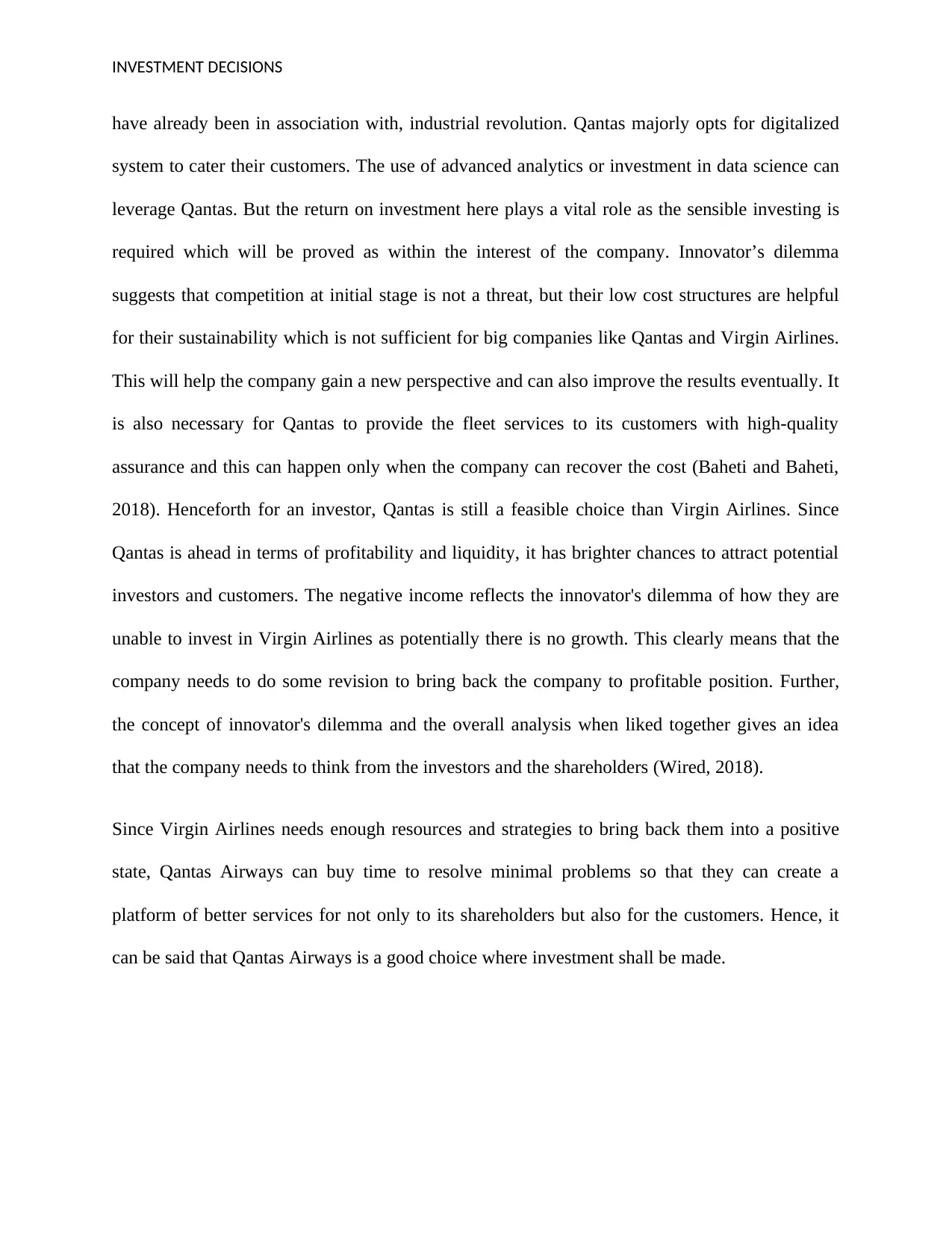
INVESTMENT DECISIONS
have already been in association with, industrial revolution. Qantas majorly opts for digitalized
system to cater their customers. The use of advanced analytics or investment in data science can
leverage Qantas. But the return on investment here plays a vital role as the sensible investing is
required which will be proved as within the interest of the company. Innovator’s dilemma
suggests that competition at initial stage is not a threat, but their low cost structures are helpful
for their sustainability which is not sufficient for big companies like Qantas and Virgin Airlines.
This will help the company gain a new perspective and can also improve the results eventually. It
is also necessary for Qantas to provide the fleet services to its customers with high-quality
assurance and this can happen only when the company can recover the cost (Baheti and Baheti,
2018). Henceforth for an investor, Qantas is still a feasible choice than Virgin Airlines. Since
Qantas is ahead in terms of profitability and liquidity, it has brighter chances to attract potential
investors and customers. The negative income reflects the innovator's dilemma of how they are
unable to invest in Virgin Airlines as potentially there is no growth. This clearly means that the
company needs to do some revision to bring back the company to profitable position. Further,
the concept of innovator's dilemma and the overall analysis when liked together gives an idea
that the company needs to think from the investors and the shareholders (Wired, 2018).
Since Virgin Airlines needs enough resources and strategies to bring back them into a positive
state, Qantas Airways can buy time to resolve minimal problems so that they can create a
platform of better services for not only to its shareholders but also for the customers. Hence, it
can be said that Qantas Airways is a good choice where investment shall be made.
have already been in association with, industrial revolution. Qantas majorly opts for digitalized
system to cater their customers. The use of advanced analytics or investment in data science can
leverage Qantas. But the return on investment here plays a vital role as the sensible investing is
required which will be proved as within the interest of the company. Innovator’s dilemma
suggests that competition at initial stage is not a threat, but their low cost structures are helpful
for their sustainability which is not sufficient for big companies like Qantas and Virgin Airlines.
This will help the company gain a new perspective and can also improve the results eventually. It
is also necessary for Qantas to provide the fleet services to its customers with high-quality
assurance and this can happen only when the company can recover the cost (Baheti and Baheti,
2018). Henceforth for an investor, Qantas is still a feasible choice than Virgin Airlines. Since
Qantas is ahead in terms of profitability and liquidity, it has brighter chances to attract potential
investors and customers. The negative income reflects the innovator's dilemma of how they are
unable to invest in Virgin Airlines as potentially there is no growth. This clearly means that the
company needs to do some revision to bring back the company to profitable position. Further,
the concept of innovator's dilemma and the overall analysis when liked together gives an idea
that the company needs to think from the investors and the shareholders (Wired, 2018).
Since Virgin Airlines needs enough resources and strategies to bring back them into a positive
state, Qantas Airways can buy time to resolve minimal problems so that they can create a
platform of better services for not only to its shareholders but also for the customers. Hence, it
can be said that Qantas Airways is a good choice where investment shall be made.
⊘ This is a preview!⊘
Do you want full access?
Subscribe today to unlock all pages.

Trusted by 1+ million students worldwide
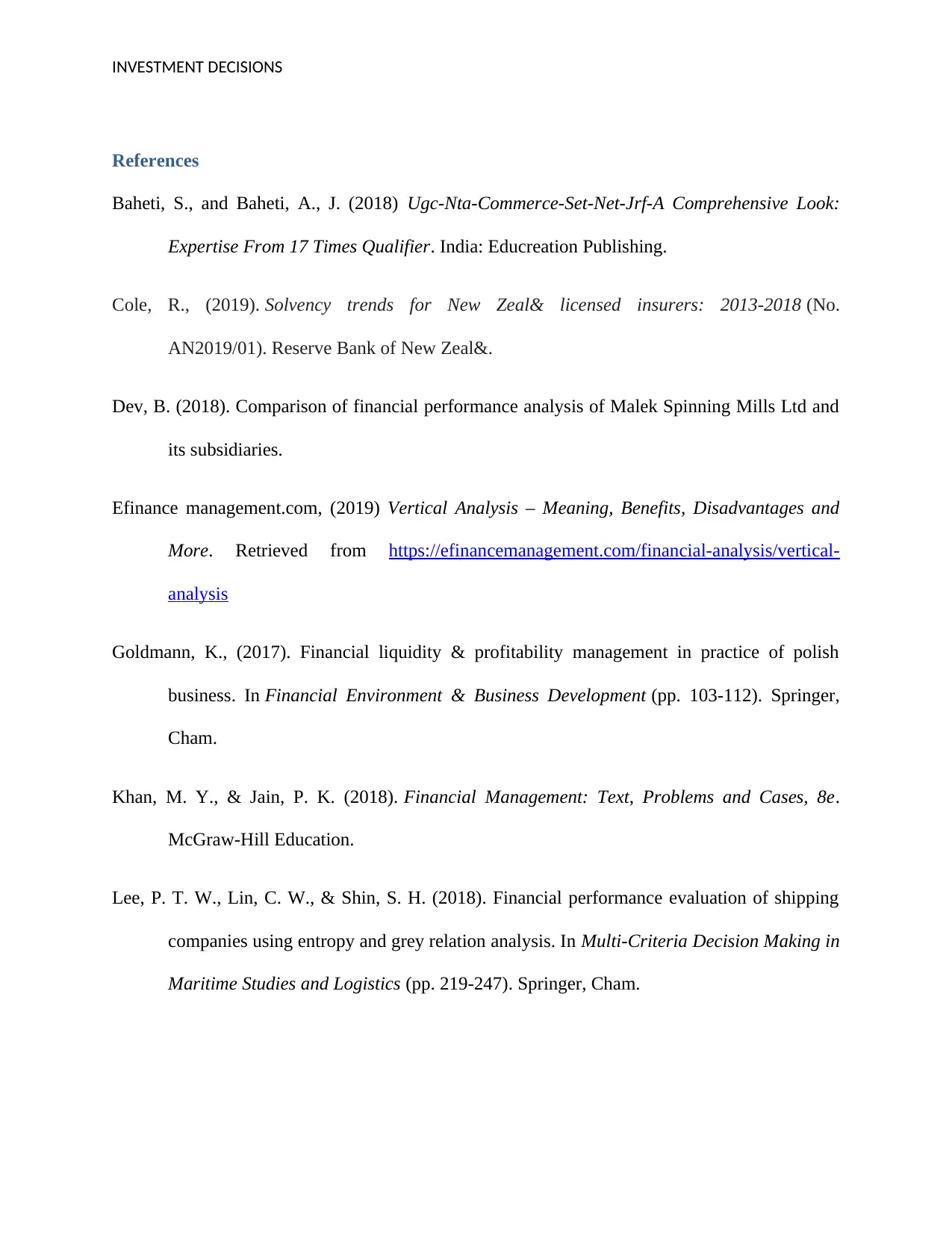
INVESTMENT DECISIONS
References
Baheti, S., and Baheti, A., J. (2018) Ugc-Nta-Commerce-Set-Net-Jrf-A Comprehensive Look:
Expertise From 17 Times Qualifier. India: Educreation Publishing.
Cole, R., (2019). Solvency trends for New Zeal& licensed insurers: 2013-2018 (No.
AN2019/01). Reserve Bank of New Zeal&.
Dev, B. (2018). Comparison of financial performance analysis of Malek Spinning Mills Ltd and
its subsidiaries.
Efinance management.com, (2019) Vertical Analysis – Meaning, Benefits, Disadvantages and
More. Retrieved from https://efinancemanagement.com/financial-analysis/vertical-
analysis
Goldmann, K., (2017). Financial liquidity & profitability management in practice of polish
business. In Financial Environment & Business Development (pp. 103-112). Springer,
Cham.
Khan, M. Y., & Jain, P. K. (2018). Financial Management: Text, Problems and Cases, 8e.
McGraw-Hill Education.
Lee, P. T. W., Lin, C. W., & Shin, S. H. (2018). Financial performance evaluation of shipping
companies using entropy and grey relation analysis. In Multi-Criteria Decision Making in
Maritime Studies and Logistics (pp. 219-247). Springer, Cham.
References
Baheti, S., and Baheti, A., J. (2018) Ugc-Nta-Commerce-Set-Net-Jrf-A Comprehensive Look:
Expertise From 17 Times Qualifier. India: Educreation Publishing.
Cole, R., (2019). Solvency trends for New Zeal& licensed insurers: 2013-2018 (No.
AN2019/01). Reserve Bank of New Zeal&.
Dev, B. (2018). Comparison of financial performance analysis of Malek Spinning Mills Ltd and
its subsidiaries.
Efinance management.com, (2019) Vertical Analysis – Meaning, Benefits, Disadvantages and
More. Retrieved from https://efinancemanagement.com/financial-analysis/vertical-
analysis
Goldmann, K., (2017). Financial liquidity & profitability management in practice of polish
business. In Financial Environment & Business Development (pp. 103-112). Springer,
Cham.
Khan, M. Y., & Jain, P. K. (2018). Financial Management: Text, Problems and Cases, 8e.
McGraw-Hill Education.
Lee, P. T. W., Lin, C. W., & Shin, S. H. (2018). Financial performance evaluation of shipping
companies using entropy and grey relation analysis. In Multi-Criteria Decision Making in
Maritime Studies and Logistics (pp. 219-247). Springer, Cham.
Paraphrase This Document
Need a fresh take? Get an instant paraphrase of this document with our AI Paraphraser
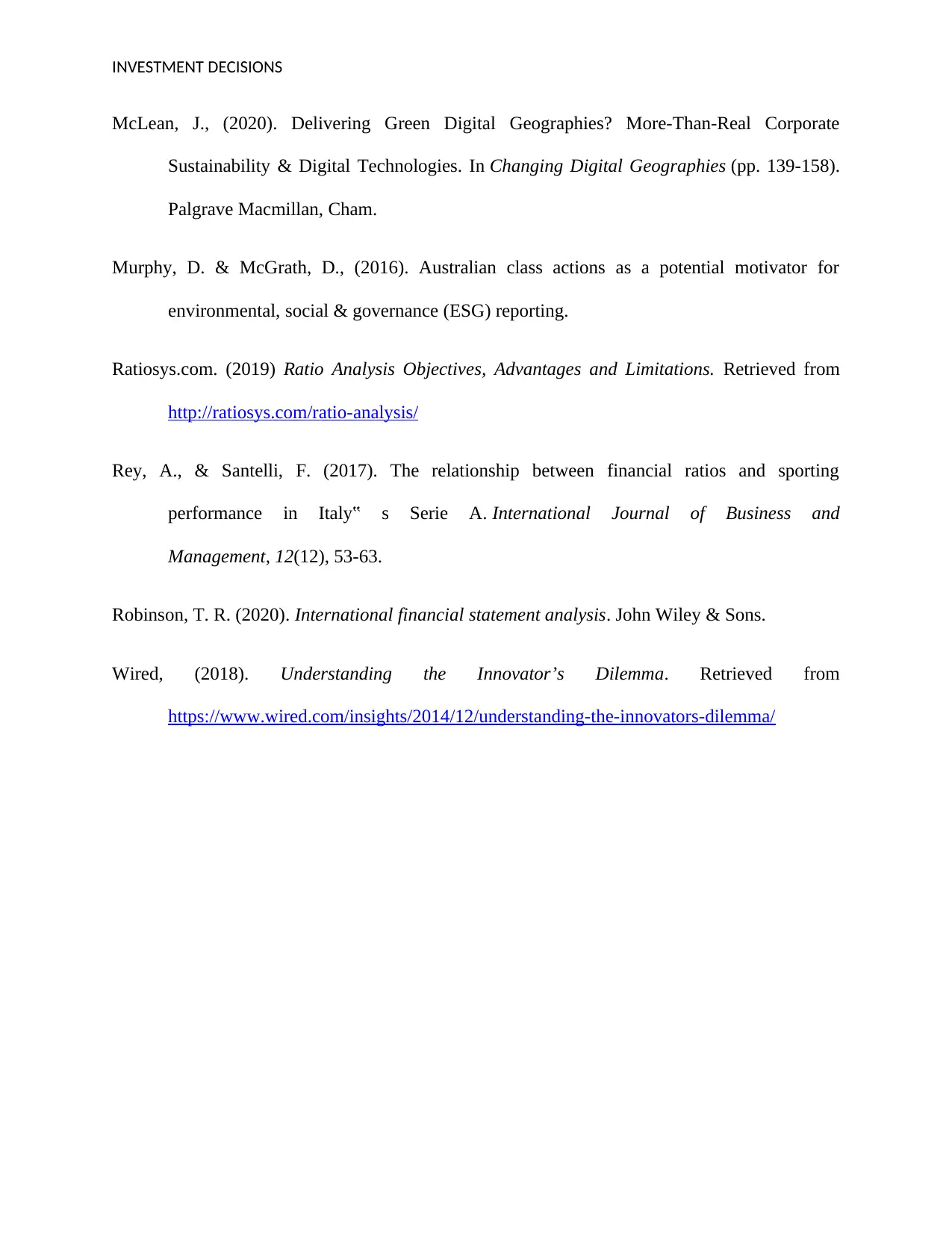
INVESTMENT DECISIONS
McLean, J., (2020). Delivering Green Digital Geographies? More-Than-Real Corporate
Sustainability & Digital Technologies. In Changing Digital Geographies (pp. 139-158).
Palgrave Macmillan, Cham.
Murphy, D. & McGrath, D., (2016). Australian class actions as a potential motivator for
environmental, social & governance (ESG) reporting.
Ratiosys.com. (2019) Ratio Analysis Objectives, Advantages and Limitations. Retrieved from
http://ratiosys.com/ratio-analysis/
Rey, A., & Santelli, F. (2017). The relationship between financial ratios and sporting
performance in Italy‟ s Serie A. International Journal of Business and
Management, 12(12), 53-63.
Robinson, T. R. (2020). International financial statement analysis. John Wiley & Sons.
Wired, (2018). Understanding the Innovator’s Dilemma. Retrieved from
https://www.wired.com/insights/2014/12/understanding-the-innovators-dilemma/
McLean, J., (2020). Delivering Green Digital Geographies? More-Than-Real Corporate
Sustainability & Digital Technologies. In Changing Digital Geographies (pp. 139-158).
Palgrave Macmillan, Cham.
Murphy, D. & McGrath, D., (2016). Australian class actions as a potential motivator for
environmental, social & governance (ESG) reporting.
Ratiosys.com. (2019) Ratio Analysis Objectives, Advantages and Limitations. Retrieved from
http://ratiosys.com/ratio-analysis/
Rey, A., & Santelli, F. (2017). The relationship between financial ratios and sporting
performance in Italy‟ s Serie A. International Journal of Business and
Management, 12(12), 53-63.
Robinson, T. R. (2020). International financial statement analysis. John Wiley & Sons.
Wired, (2018). Understanding the Innovator’s Dilemma. Retrieved from
https://www.wired.com/insights/2014/12/understanding-the-innovators-dilemma/
1 out of 11
Related Documents
Your All-in-One AI-Powered Toolkit for Academic Success.
+13062052269
info@desklib.com
Available 24*7 on WhatsApp / Email
![[object Object]](/_next/static/media/star-bottom.7253800d.svg)
Unlock your academic potential
Copyright © 2020–2025 A2Z Services. All Rights Reserved. Developed and managed by ZUCOL.





